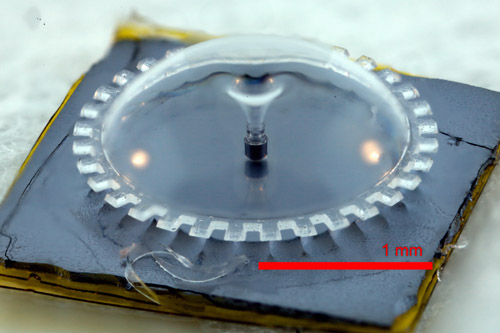By Kalwinder KaurSep 24 2012
DARPA is devising new and low-cost fabrication techniques for microscale inertial sensors to improve their precision and help replace the existing gyroscopes. Under the MRIG (Microscale Rate Integrating Gyroscope) effort of the Micro-PNT (Micro-Technology for Positioning, Navigation and Timing) program, this initiative is being carried out.
 Microfabrication methods to help navigate a day without GPS (University of California, Irvine Image)
Microfabrication methods to help navigate a day without GPS (University of California, Irvine Image)
The first phase was accomplished recently, where MRIG targeted nontraditional materials-based 3-D microfabrication techniques. Fabrication of small 3-D structures like hemispheres, wineglass-shaped structures and toroids were achieved, transforming from the 2-D paradigm of contemporary microgyroscopes.
The operation of microscale inertial sensors resembles Foucault pendulums in museums. Rather than a swinging pendulum, microscale inertial sensors transmit vibrations through the surface of a 3-D structure. Evaluation on the precession of the standing wave is done and any alteration will impact the orientation. For integrated operation with the microscale inertial sensors, DARPA has developed new fabrication methods such as:
- Glass-blowing: Inspired by the traditional glass-blowing techniques at the microscale, very small 3-D wineglass-shaped inertial sensors were created. These sensors are symmetrical and have frequency split up to 10 hz.
- Blown quartz: Resembling glass blowing, quartz blowing is effective for creating more symmetric structure. Scientists designed fabrication techniques that can heat quartz to 1,7000 C followed by rapid cooling. The fabrication is performed in massive batches, resulting in several devices on a single wafer.
- Atomic layering of diamond: Depositing CVD diamond in a micro-well on the substrate or layering diamond over a blown structure was successful, leading to highly symmetric, precise 3-D inertial-sensor structures.
Phase 2 performers focus on developing these devices, where their precision and reliability were enhanced by decreasing frequency split from 10 Hz to 5 Hz, decreasing volume from 20 to 10 mm3, and by raising decay times from 10 to 100 sec. Demonstration of a unique, working microrate integrating gyroscope is the final objective of Phase 2.
Disclaimer: The views expressed here are those of the author expressed in their private capacity and do not necessarily represent the views of AZoM.com Limited T/A AZoNetwork the owner and operator of this website. This disclaimer forms part of the Terms and conditions of use of this website.